The Soong Axis, Forgotten Dynasty
Tuesday, December 19th, 2006Sisters and Actresses 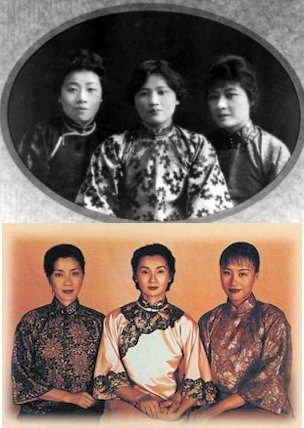
Read about the Soong family featuring four famous American educated siblings, three of which were notorious for their corruption.
Vitro NasuIconoclastic Incubator
|
Sisters and Actresses 
Read about the Soong family featuring four famous American educated siblings, three of which were notorious for their corruption.
Today (Nov 2) is the birthday of a famous artist/poet/Taoist Emperor who lost his kingdom for his love of art, luxury and culture.
Emperor Huizong was born on November 2, 1082.
Emperor Huizong 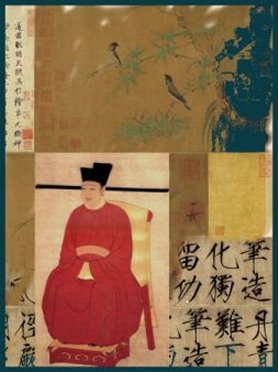
Zhao Ji (Emperor Huizong) was an artistic emperor ruled from 1100 to 1126 AD. The cost of his ardor for the art and fatuity in government affairs was grievous: when his capital fell into Nuchen hands in 1127, he was taken prisoner, spending the rest of his life in a remote, bleak, desolate land.
(from the History of Chinese Calligraphy)
Partial view of Court Ladies Preparing Newly Woven Silk from the Museum of Fine art Boston.
The Politics of Culture and the Culture of Politics, subtitle of this book from Harvard Press.
Emperor Huizong and Late Sung Northern China
Huizong was an exceptional emperor who lived through momentous times.
Here is a western painter who continued in the Chinese tradition and is going around in a media blitz today.
Joseph Duemer really wants to see Brice Marden at MoMa for his retrospective exhibition.
The exhibition shows him as an artist who has spent his career assiduously converting the rule-ridden zone of Minimalist abstraction into a capacious yet disciplined place, pushing it toward landscape and the figure while reconnecting it to its roots in Abstract Expressionism and beyond, in non-Western art. It makes perfect sense that one of the greatest influences on Mr. Marden’s recent work has been Chinese art, where originality is a much fuzzier, more nuanced concept. His inspirations include calligraphy, landscape painting, scholars’ rocks and ceramics. (Roberta Smith from NYtimes.)
Brice Marden 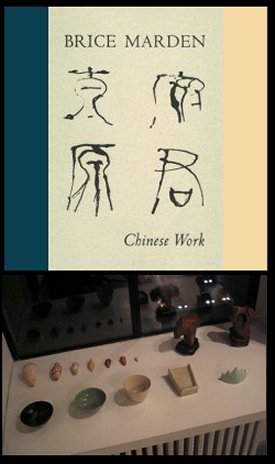
Brice Marden and his studio
Here is a harsh but entertaining review by Finch on Marden at MoMa.
Jackson Pollock would have headed for that tree a lot earlier if he had painted like Brice.
Brice was at the MoMA opening Thursday in a black wool hat, quietly the center of attention, apparently still wondering if his paintings were any good, looking for validation.
He should have been in the studio, trying something new. And maybe in another 20 years, he will.
(Finch does not appreciate Chinese art? Like Finches and Bamboo or baboons)
“How I wish I had never read this article about Brice Marden’s intimate relationship with Bounty paper towels.” (via culturegirl)
Let’s hear from Brice himself.
Basically I decided to be a painter because I loved the lifestyle. Later, at Yale’s graduate school, I had Jack Tworkov as a teacher who would come in and say, “that’s a cliché on De Kooning,” “that’s a cliché on Kline,” and so on. And I said, “well, how do you get rid of it?” Then the next thing you know you’re living on the Lower East Side . It just happened overnight.
His sister in law was Joan Baez.
And when I got into New York, my scene was the folk scene. It wasn’t really at Max’s Kansas City, because at that time I didn’t really know any artists yet. And that’s when Dylan was going around Joanie. (from In Conversation Brice Marden with Jeffrey Weisse.)
Brice Marden and Emperor Huizong were brought together once before, here.
(He does have a great name: Brice Marden. With a name like that he could have been a movie star and a lot luckier than the ill fated Taoist Emperor.)
High price to pay for China’s wealth reads this headline.
China is changing and the city people are abandoning bicycles for cars these days. Chinese automaker Geely plans to move aggressively to U.S. market by 2008.
Bikers by Zhang Hongtu or Mr Momao
Zhang Hongtu or Mr Momao
Zhang Hongtu whose portrait of Mao’s last supper was featured last year when Jung Chang’s Mao book was released.
Picked up Yu Hua’s To Live from the library. It is a slim book for an epic story that was adapted to an award winning film with the same title by Zhang Yimou. Unlike the huge book on Mao by Jung Chang, Yu Hua’s light book was easy to carry on my bike. (The spouse had just finished reading Mao Tse Tung, since then he never stopped talking about Mao’s atrocity and monstrous acts on his people. He was a Sun Emperor who scorched everyone who came close to him. )
The differences of the novel and film adaptation are discussed from this review.
Film review “To Live’ as allegory of historical discourse” and this page with more photos and reviews.
This web page on Lu Xun was bookmarked about a week ago and the fate has it his name got repeatedly mentioned in the afterword section of Yu Hua’s To Live and also from the conversation from the above link.
Lu Xun wikipedia page is here.
Update: just stumbled upon on this review of Zhang Yimou’s new film “Riding Along for Thousand Miles” by Rob Smith. Zhang wrote this film for Takakura Ken a 74 years old veteran of Japanese cinema known in the west for the movie “The Yakuza” with Robert Mitchum.
“Saturated in hothouse colors, the three-act “Lantern” is an intense dance-theater version of the multi-award-winning film by Chinese auteur Zhang Yimou (“Hero,” “House of Flying Daggers”). The stage version is as lush and fluidly cinematic as Zhang’s — which, ironically, was banned in China when it was released in 1991.” (LA Times)
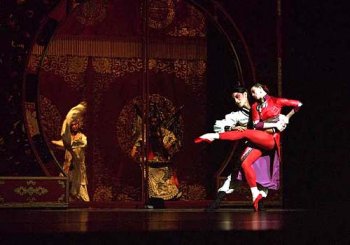
“Raise the Red Lantern is now a “Chinese Ballet making an American premiere this month in Berkeley and will be also at the Orange County Performing Arts Center for six performances beginning Tuesday. (The company then goes to the Kennedy Center in Washington, D.C., and the Brooklyn Academy of Music in New York.)
“Having seen and admired the film of the same name, I have to report that the ballet is entirely different and only the theme of female subjugation remains” (from past review when it showcased in England)
A few days ago BBC had this curious article about Mosuo Women in China – it says ” The Chinese region with women in charge”
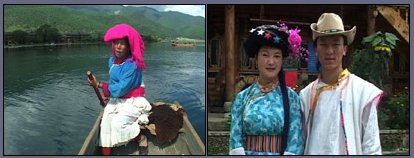
The two images from BBC.
Now read Mr. Zhang Jia in a comment to the blog Peking Duck referring to this same article.
“A huge fuss is made of the supposedly “matriarchal” Mosuo who live around Lugu Lake. The Mosuo were just one of a whole patchwork of local ethnic groups who had adapted in different ways to their environment. They mingled with Tibetans who practised polyandry [several brothers, one wife] and Han Chinese who still practise polygamy with their Da Laopo and Xiao Laopo. The Mosuo were a lot more than just a matriarchal society: to label them as some unique sexual social group is to misrepresent them as freaks. Unfortunately, they have attracted the attention of prurient tour group visitors who come thinking that they will be able to partake of casual sex in the name of a “walking marriage”.
If you want to read more about the traditional mix of Mongols, Mosuo, Pumi, Naxi and Tibetans in this area, try:
In the Footsteps of Joseph Rock
Edge on Dan Sperber talking about Anthropology.
“Anthropologists started studying themselves and trying to reflect on their own situation. It was a kind of reflective anthropology, which had a number of interesting aspects. I certainly don’t think it was useless although it became a bit obsessive. Parallel to these developments, were the post-structuralist and then post-modernist movements in the humanities and the social sciences, the development of “cultural studies,” and many anthropologists felt at ease in these movements. This produced a new kind of discourse, taking the study of other cultures as much as a pretext as a subject matter to be investigated in a standard scholarly manner. Again, some of the products of this appraoch are of genuine interest, but on the whole more harm has been done than good.”
1) Leave it to Bush (well crafted animation by Ken McKintyre.)
2) Celebrity Verite – Brad Pitt is a closet conceptual artist – his collaborator Fashion photographer Steven Klein is showing his work at Gagosian L.A. ( for above 2 links from here)
3) On this day today (August 3) in Milan and Sicily:
1778 The opera house La Scala opened in Milan, Italy, with a performance of Antonio Salieri’s ”Europa riconosciuta.’
1943 Gen. George S. Patton slapped a private at an army hospital in Sicily, accusing him of cowardice.

4) Sky Burial and One woman broke the silence.
5) Something caught my attention.
6) Sokurov on Emperor Hirohito, The Sun. (Added Sokurov’s homepage to vitro nasu sidebar menu.)
The comic Japanse actor Issey Ogata plays the Emperor Hirohito.
“Recently, Ogata has been basking in the limelight, having played the lead in two critically acclaimed feature films. One is “Tony Takitani,” the latest work by Japanese director Jun Ichikawa, which is based on a short story by the best-selling and world-renowned novelist, Haruki Murakami. ” (More here – you can see the chameleon in the sample photos of Ogata playing different characters.)
China’s mother tongue is dying.
* Generations of women passed down a unique form of writing that was kept away from men. Now a 95-year-old may be the last alive who grew up using nushu.
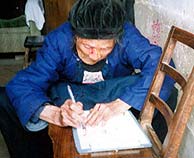
Picture from here.
“When I learned nushu, it was to meet with friends and sisters to exchange our thoughts and letters. We wrote what was in our hearts, our feelings,” Yang said. “But now,” she added with a sigh, “there’s no use learning it anymore.”
Nushu on the left
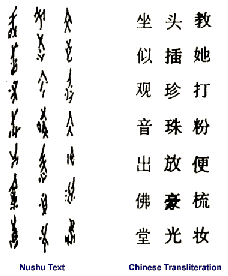
Chasing Nushu resulted in woven cloth.
Nushu did not produce its Tale of Genji (first great novel written by Lady Murasaki) and Nushu sounds like Nasu which means eggplant in Japanese.
The world of Nushu.
This is China’s new power language – Yuan shu
Y U A N

digital image July 22, 2005
The honorary China man from Australia
Chris Doyle said this of Wong Kar Wai from the Observer.
“2046 was a kind of sequel to In the Mood for Love, and, he says: ‘I feel that 2046 is unnecessary, in retrospect. I think probably Wong Kar-Wai realised that somewhere, and that’s why it took so long. You do realise that you have basically said what you needed to say, so why say more? I feel that way. I think you have to move on.’
Chris is the most honest drunken cinematographer.
This is an example of Nansu (man’s language in Chinese), old friends showing comradrie and affection – or do you think they are having a serious rift?
Eat only Big Mac and Kentucky Fried Chickens in China if you want to be safe, a warning from Peking Duck, from here.
Jung Chang and her husband’s book”Mao:The Unknown Story’ is out and a review is here.
“the book uses sources they have unearthed that reveal Mao as a psychopathic leader, responsible for the deaths of 70 million, and driven by a hunger for power.”
“Mao was deeply influenced by Fredrick Paulsen, a minor German philosopher who shunned all constraints of responsibility and duty. He put his theories into practice during the Long March and in Yenan, the Communists’ first headquarters in China.”
“Contrary to the perceived idea that Stalin disapproved of Mao, Halliday says these documents revealed that the Soviet leader had talent-spotted his Chinese counterpart and nurtured his power-base from the 1920s. “Mao always perpetuated the myth that he’d risen to power without help from the Russians. But he was the one that the Russians were pushing and protecting.” The material Halliday unearthed on four trips to Moscow was so extraordinary, he remembers leaving the archives at 4pm every day, bathed in sweat.”

The Last Banquet by Zhang Hongtu/Hongtu Zhang
“Sometimes the hole in my work might remind you of the Nothingness of Taoism or the negative space of traditional Chinese ink painting, but the visual inspiration of my work comes directly from a bagel.”
(via)
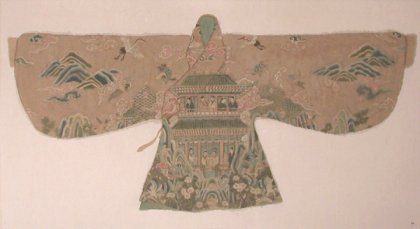
PENG WEI (b. 1974)
Robe / Palace on the Immortal Mountains
Ink and color on paper, with one seal of the artist, Peng Wei
(From The Ancient Robe – New Ideas.)
Christopher Doyle is working with James Ivory on a film called White Countess screenplay written by Kazuo Ishiguro.
Plot Outline: Set in 1930s Shanghai, where a blind American diplomat develops a curious relationship with a young Russian refugee who works odd — and sometimes illicit — jobs to support members of her dead husband’s aristocratic family. (Yahoo, Imdb). This seems not be an adaptation of Ishiguro’s novel “When We Were Ophans” which also takes place in Shanghai. Ralph Fiennes, the Redgrave women (Natasha, Vanessa and Lynn) all star in this film.
Going back to Chris D. found this article, “He can barely stop himself laying into Lost in Translation. “It’s articulating the Bush doctrine of how to engage with the rest of the world. Let’s all be Americans, that’s what it’s saying.” (Wow, Sofia paid a tribute to Wong Kar Wai in her Oscar acceptance speech. She must work with materials she feels close to and she only knows of the bored and the rich Americans. )
Christopher Dolye’s life so interesting that I overlook his Asian bias. Watch all the films he made in the past and you participate in an important film history in progress.
Working with Wong Kar Wai, Richard Corliss from Time Asia wrote, “Cinematographer Christopher Doyle matches the director’s artistry and energy with a luscious camera style that sees beyond surfaces into essences. He takes ravishing pictures of troubled souls.” More on here.
Have not seen 2046, or Last Life in the Universe. Can’t wait to see them.
C. Dolye made two films with his fellow Aussie director Philip Noyce. “The Rabbit Proof Fence” and “the Quiet American” were excellent.
(The Not So Quiet American by Zizek, here.)
 by Jung Chang. Three generations of women in revolutionary China. The grandmother with bound feet is concubine to a warword. The mother is a communist revolutionary cadre caught up in the purges of the cultural revolution. The daughter is a child of the cultural revolution itself. Covers the sweep of history through the remarkable stories of these three women.
by Jung Chang. Three generations of women in revolutionary China. The grandmother with bound feet is concubine to a warword. The mother is a communist revolutionary cadre caught up in the purges of the cultural revolution. The daughter is a child of the cultural revolution itself. Covers the sweep of history through the remarkable stories of these three women.